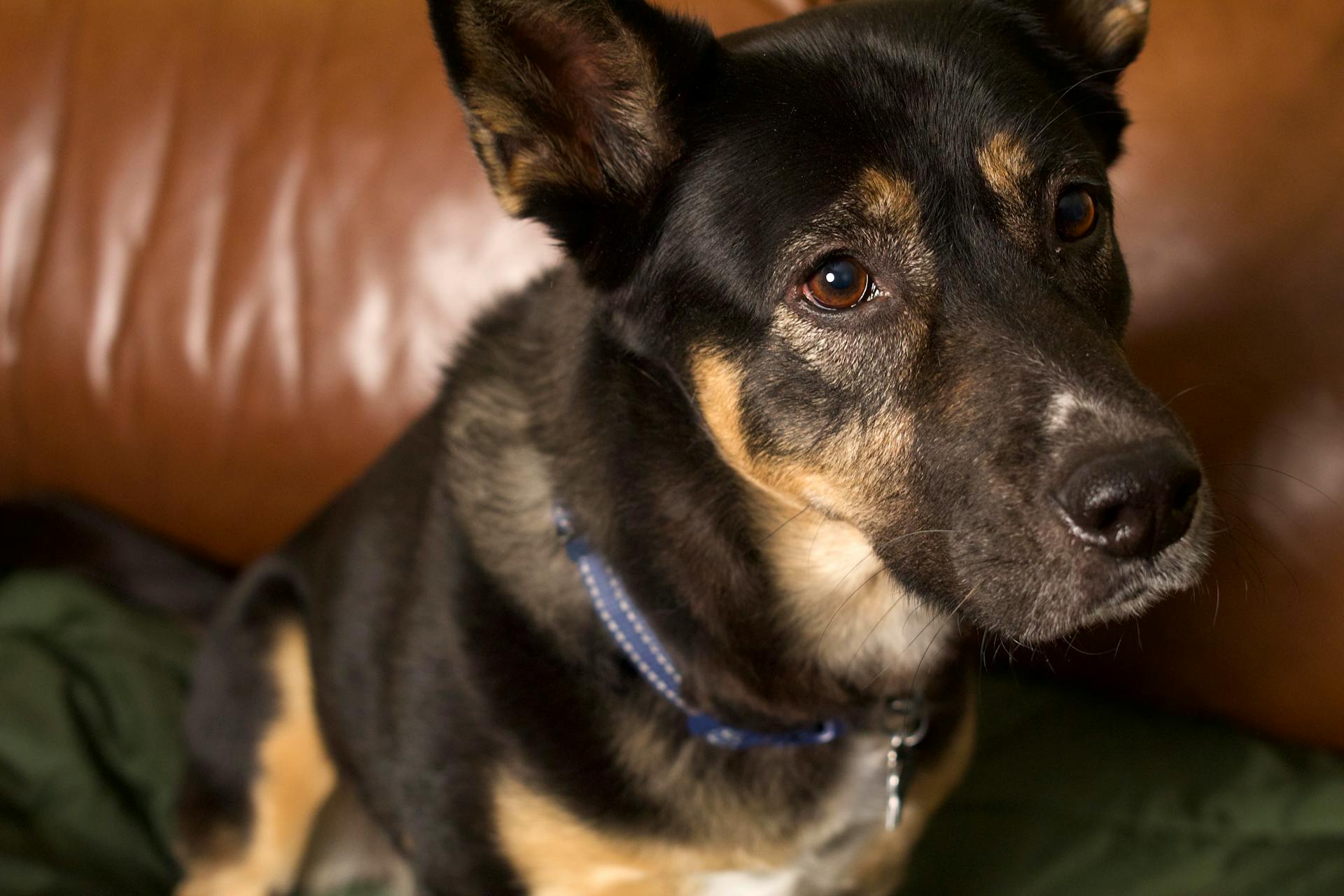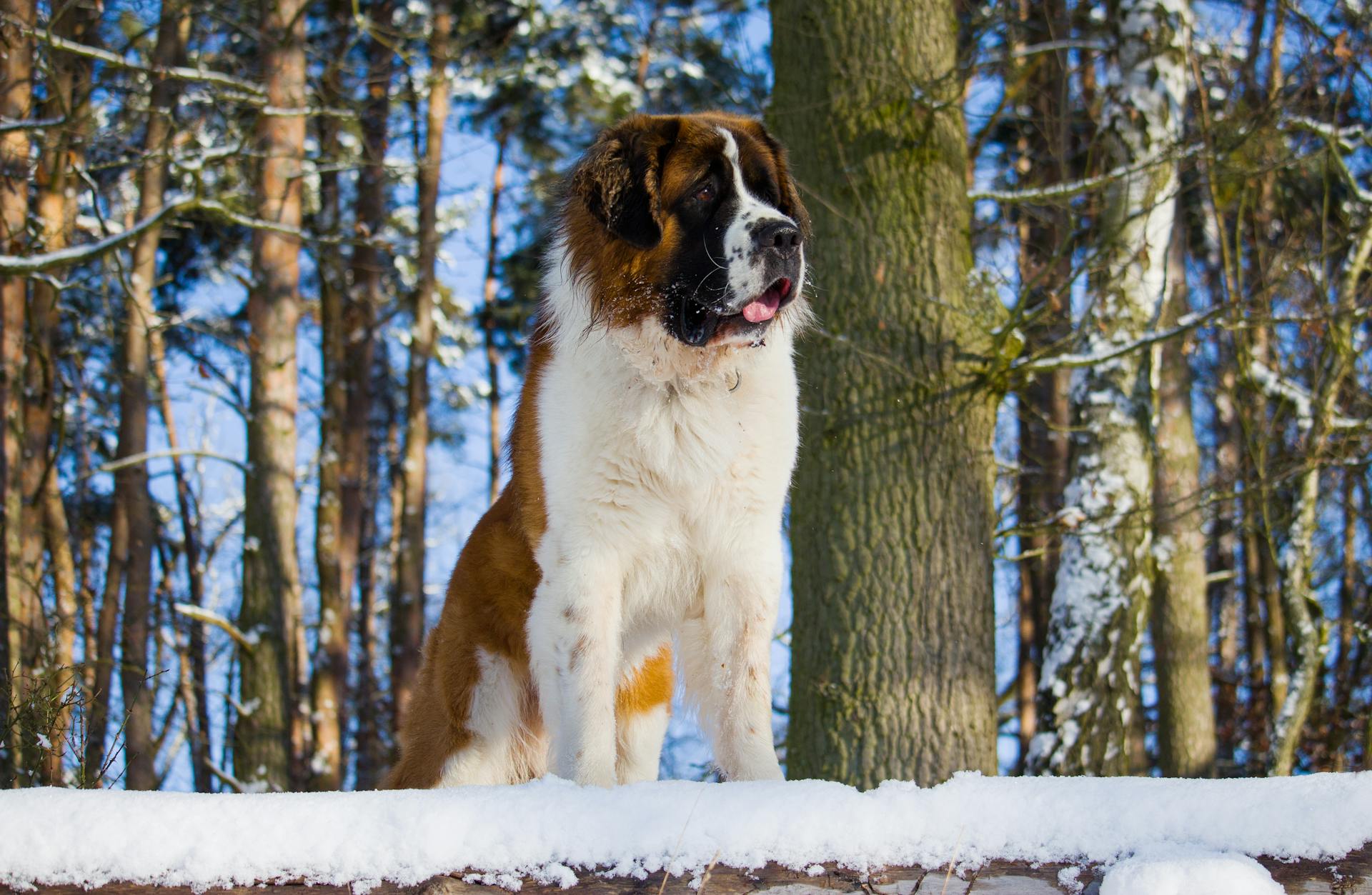
The St Bernard Lab Mix is a gentle giant, perfect for active families who want a loyal companion. This breed is a result of crossbreeding a St Bernard with a Labrador Retriever.
They inherit the St Bernard's calm and gentle nature, making them an excellent choice for families with children. Their friendly and outgoing personalities ensure they get along with everyone.
One of the most notable features of the St Bernard Lab Mix is their intelligence. They are highly trainable and can learn a wide range of commands and tasks with ease.
Lab Health
Lab Health is a crucial aspect of owning a St Bernard Lab mix. This breed is prone to certain health issues, so it's essential to be aware of them.
Gastric Torsion is a serious condition that can occur in St Bernard Lab mixes. It's a life-threatening emergency that requires immediate veterinary attention.
Hip and Elbow Dysplasia are common health problems in this breed. Regular exercise and a healthy weight can help prevent or manage these issues.
Otitis Externa is an ear infection that can cause discomfort and pain for your St Bernard Lab mix. Regular ear cleanings and inspections can help prevent this condition.
Entropion is a condition where the eyelid rolls inward, causing the eyelashes to rub against the eye. This can lead to eye irritation and infection.
Cataracts and Progressive Retinal Atrophy (PRA) are eye conditions that can cause vision loss and blindness. Regular eye exams can help detect these conditions early on.
To monitor your St Bernard Lab mix's health, it's essential to perform regular X-Rays, ear examinations, eye examinations, and full physical examinations.
Breed Maintenance
Your St. Bernard Lab mix will need regular brushing to get rid of loose hair and prevent tangles. Brushing every second day with a pin brush will keep your pet looking good, but daily brushing may be necessary if their hair is a bit longer.
They're not hypoallergenic, so be prepared for some shedding and drooling. A shedding blade can be used during heavy shedding to keep things under control.
Bathing is not a regular necessity, but they will need it if they get very dirty. You'll also need to check their ears often for signs of irritation, as they're prone to ear infections.
Their nails should be checked regularly to see if they need clipping, and don't forget to brush their teeth to prevent tartar buildup and bad breath.
Lab Temperament
The Lab Temperament is a wonderful thing. They're generally calm, friendly, and loving, making them a great addition to many families.
Labernards are very tolerant and patient with children, which is a big plus for families with little ones. However, small children should still be monitored around them to prevent any accidental injury.
They're also good with strangers, thanks to their sweet personalities. But don't worry, they'll still bark to alert the family of intruders.
Labernards don't do well being left by themselves and will thrive with large, active families where there is someone home most of the time.
They're highly intelligent, which makes them easy to train. But, they do have a mind of their own, so a firm, confident hand is necessary when training.
One thing to keep in mind is that Labernards are not good in hot weather and can suffer from heat exhaustion. So, try to exercise them when it's cooler and make sure they have plenty of water.
Care and Needs
A Labernard is an active energetic dog who will need daily exercise. It will depend on which parent breed your dog most takes after.
Labrador Retrievers need a lot more intensive exercise compared to a Saint Bernard. Saint Bernards don’t cope well in the heat so take care in summer when exercising your pet.
Your Labernard will do better in a house with a fenced in yard than an apartment.
A fresh viewpoint: Saint Bernard Mix Dogs
Grooming Needs
Regular grooming is essential for the health and well-being of your pet. This includes nail trimming, which helps prevent overgrowth and painful cracking.
Your pet's coat type will determine how often they need to be brushed. For example, short-haired pets like dogs may only need to be brushed once a week, while long-haired pets like cats may require daily brushing to prevent matting.
Daily dental care is crucial for preventing tartar buildup and promoting good oral health. You can use a dog-specific toothbrush and toothpaste to brush your pet's teeth.
Bathing your pet too frequently can strip their coat of its natural oils, leading to dryness and irritation. Instead, aim to bathe your pet only when necessary, such as after a muddy romp or a long hike.
Some pets may require regular trimming of their facial hair, such as dogs with long beards or mustaches. This can help keep their face clean and prevent food from getting stuck in their fur.
For more insights, see: Short Haired Border Collie Terrier Mix
Coat Care
To keep your coat looking its best, brush it regularly to prevent matting and tangling. This will also help distribute natural oils throughout the coat, keeping it healthy and shiny.
Brushing is especially important for long-haired breeds, as their coats can easily become matted and knotted if not properly maintained. Regular brushing can also help reduce shedding and prevent hair from getting everywhere.
A good quality brush specifically designed for your coat type is essential for effective brushing. Using the right brush will help prevent breakage and damage to the coat.
Regular grooming sessions can also help strengthen the bond between you and your pet, making it a great opportunity for some quality time together.
Care and Needs
Labernards need daily exercise to stay healthy, and they'll enjoy activities like playing frisbee or going for a swim. A 30-minute to an hour daily exercise routine is ideal for them.
They'll thrive in a house with a fenced-in yard, where they can run around and play outside. Saint Bernards, one of their parent breeds, don't cope well in the heat, so take care when exercising your Labernard in summer.

Your Labernard will form close attachments to their people, so they'll love going on walks or runs with you. They're not outside dogs, though, and will need to live inside with the family.
Ball games are a great way to keep your Labernard happy and mentally stimulated, which can prevent bad behavior from appearing.
Lab Owner Experiences
If you're looking for a registered Labernard breeder in NSW, Australia, you're not alone in your search - one owner had trouble finding a breeder to contact.
Labernard owners often report having difficulty finding reputable breeders, as this owner did.
You can start by reaching out to local breed clubs or organizations that specialize in St Bernards or Labradors, as they may be able to provide you with a list of registered breeders.
A search online or through word of mouth can also be a good starting point, but be sure to do your research and only contact breeders who are registered and have a good reputation.
It's not uncommon for Labernard owners to have a strong connection with their pets, and with the right breeder, you can find a wonderful companion.
You might like: Lab Weimaraner Mix Breeders
Labrador Retriever Mix
A Labrador Retriever mix is a wonderful companion for families. They're known to be even-tempered, playful, and very sweet.
Their size can be quite a surprise, ranging from 50 to 180 pounds, so be prepared for a giant breed. You'll want to make sure your home is spacious enough to accommodate their growth.
Labrador Retriever mixes are generally excellent with children, exhibiting significant patience. This makes them a great choice for families with kids.
They do enjoy family time and can get destructive when left alone for long periods. So, it's essential to provide them with plenty of attention and exercise.
With proper training, you'll have a docile and sweet pup on your hands. Just remember to be consistent and patient with their willful nature.
Explore further: Dog That Looks like a Lab but Smaller
Final Thoughts
The Saint Bernard Lab mix is a wonderful companion that adds a mix of gentleness and loyalty to any family.
They've been a favorite for many years, and for good reason - they're loving and sweet.
Considering owning a Saint Bernard Lab mix? Being open to a mix can reward you with health benefits and a longer lifespan.
Not only will you be saving a life, but you'll likely save money on the long-term costs and care of your dog.
You'll find your next best friend among the amazing Saint Bernard Lab mixes out there.
Temperament & Intelligence
The Labernard is a gentle, friendly dog that is loving to its family and very tolerant and patient with children. They are good with strangers because of their sweet personalities but will bark to alert the family of intruders.
Both the Labrador and the St. Bernard are working dogs, so they are very intelligent and easy to train. The Labernard should be highly trainable, but it's essential to provide plenty of mental stimulation to keep them from getting bored.
The Labernard will need a firm, confident hand when it comes to training as they do have a mind of their own. But being intelligent, they will respond to positive reinforcement.
These dogs don’t do well being left by themselves and will thrive with large, active families where there is someone home most of the time.
Pet Compatibility
If you're considering bringing home a St Bernard Lab mix, you'll want to think about their compatibility with other pets. They can get along with other animals, but early socialization training is key.
With proper training, they'll likely have no problem living with other pets. It's best to introduce them to other animals at a young age to help them adjust.
If you're adopting a puppy or kitten, it's best to do it young so they can grow up together. This will make the transition smoother for both pets.
Labernards don't have a high prey drive, which means they're not as likely to chase cats like some other breeds.
Food and Diet
A St Bernard Lab mix can weigh up to 180 pounds, so they need a lot of food to stay healthy.
Their diet should be well-balanced, not just cheap, because cheaper dog food is often less nutritious.
You'll need to talk to your vet to figure out the best food for your St Bernard Lab mix, as their needs will depend on their health, weight, age, and activity level.
On average, they'll eat between 3 and 6 cups of dry food every day.
This means you'll need to plan your grocery shopping and budget accordingly to ensure they get the right amount of food.
Their size and appetite mean they'll need regular, nutritious meals to stay healthy and happy.
Frequently Asked Questions
How big will my Lab hound mix get?
Your Labloodhound mix is likely to be a large dog, weighing over 100 pounds, with a sturdy build and powerful physique. Expect a robust and athletic companion with a deep chest and strong shoulders.
How big do Saint Bernard mixes get?
Saint Bernard mixes, also known as Saint Danes, typically weigh between 120 to 190 pounds. They are one of the larger breeds, so be prepared for a big dog.
How big does a labernese get?
A Labernese typically grows to be 23-28 inches tall at the shoulder and weighs 70-110 pounds. They have a medium to long-length double coat.
What is a Saint Bernard Labrador called?
A Saint Bernard Labrador is commonly known as a Labernard, a large dog breed resulting from the cross between a Labrador Retriever and a Saint Bernard.
How long does St. Bernard Lab Mix live?
A St. Bernard Lab Mix can live 8-14 years with proper care, similar to its parent breeds. With the right attention, this mixed-breed dog can enjoy a long and healthy life.
Featured Images: pexels.com


